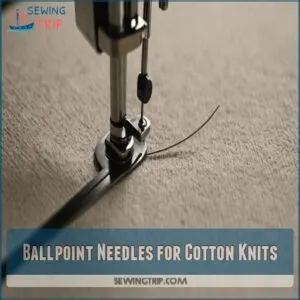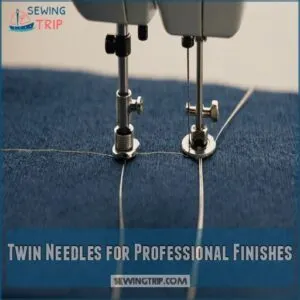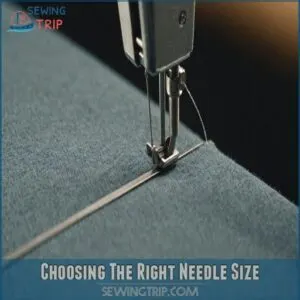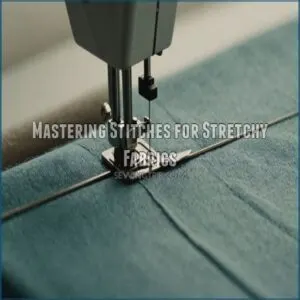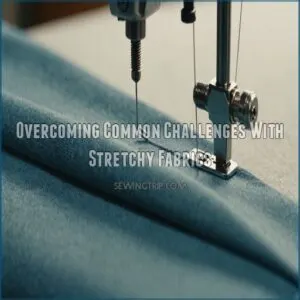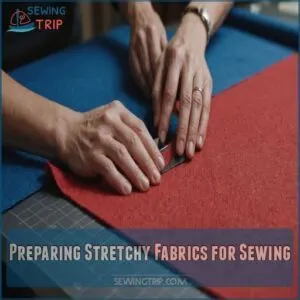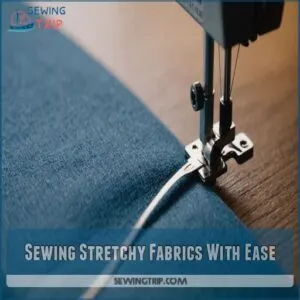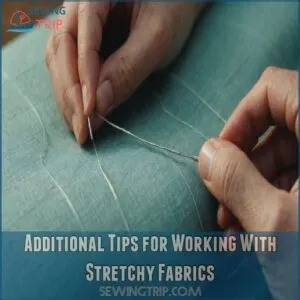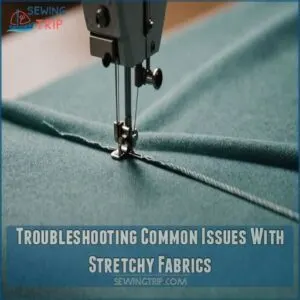This site is supported by our readers. We may earn a commission, at no cost to you, if you purchase through links.
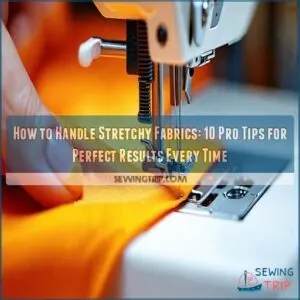
Start by choosing appropriate fabric with good recovery.
Use a stretch or ballpoint needle to avoid snags, and opt for a stretch stitch or narrow zigzag to keep seams flexible.
Don’t forget to adjust your machine’s tension and use a walking foot to prevent fabric from bunching.
Pre-wash to minimize shrinkage and always cut with sharp scissors for precision.
Curious about mastering these stretchy wonders?
Stay tuned for pro tips that’ll have you taming fabrics like a seasoned tailor!
Table Of Contents
- Key Takeaways
- Choosing The Right Stretchy Fabric
- Essential Tools for Sewing Stretchy Fabrics
- Needles for Stretchy Fabrics
- Mastering Stitches for Stretchy Fabrics
- Handling Specific Stretchy Fabrics
- Overcoming Common Challenges With Stretchy Fabrics
- Preparing Stretchy Fabrics for Sewing
- Sewing Stretchy Fabrics With Ease
- Additional Tips for Working With Stretchy Fabrics
- Troubleshooting Common Issues With Stretchy Fabrics
- Frequently Asked Questions (FAQs)
- Conclusion
Key Takeaways
- Use a ballpoint or stretch needle to avoid snags and ensure smooth sewing with knits and spandex.
- Choose a stretch stitch or a narrow zigzag stitch to keep seams flexible and prevent them from popping.
- Employ a walking foot to evenly feed fabric through the machine, avoiding bunching and distortion.
- Pre-wash fabrics to minimize shrinkage and stabilize edges with fabric starch or hairspray to prevent curling.
Choosing The Right Stretchy Fabric
You’ll need to check both the weight and stretch percentage of your fabric to make sure it matches your project’s requirements.
Whether you’re making leggings that need maximum stretch or a flowy dress that needs gentle drape, choosing the right stretchy fabric will make the difference between a garment you’ll love and one that’ll end up in the donation pile.
Understanding Fabric Weight and Stretch Percentage
When picking stretchy fabrics, think of them like a rubber band – they need the right weight and stretch to work well.
Light fabrics (5-8 oz) are perfect for t-shirts and tops, while medium weights (8-12 oz) suit leggings and dresses.
Check the stretch percentage by pulling the fabric – good stretch should give you 25-50% in the width direction without straining.
This makes sure your garment will move comfortably with you.
Considering Recovery and Fabric Blend
Through your fabric’s recovery rate and blend mix, you’ll discover if it’s right for your project.
Look for fabrics that bounce back to their original shape after stretching – that’s good recovery.
A blend with 5-20% elastane or spandex provides the sweet spot for stretch, while the main fiber (like cotton or polyester) determines how it feels and breathes.
Selecting Suitable Fabric for Garments
Now that you understand fabric recovery and blends, let’s match fabrics to garments.
Lightweight jersey with medium stretch works great for flowy tops and dresses.
For leggings and activewear, pick high-stretch spandex blends that bounce back quickly.
T-shirts and casual wear do best with medium-weight cotton knits offering moderate stretch.
Remember – the right fabric choice makes sewing smoother and your finished garment more comfortable.
Essential Tools for Sewing Stretchy Fabrics
After picking your fabric, let’s get your toolkit ready for success.
You’ll want to stock up on a few game-changers that’ll make sewing stretchy fabrics feel like a breeze.
Knowing the Fabric Stretch Percentage is key to choosing the right fabric for your project.
Start with a walking foot – it’s like having an extra set of hands guiding your fabric evenly.
Keep polyester thread handy; it’s got just enough give to move with your fabric.
Your pressing tools matter too – grab a pressing cloth and set your iron to low heat to avoid warping those delicate knits.
Don’t forget fabric stabilizers for those tricky edges, and clear elastic for reinforcing seams that need extra support.
A rotary cutter with a sharp blade will give you clean cuts without stretching the fabric out of shape.
Needles for Stretchy Fabrics
You’ll need the right needle to keep your stretchy fabrics from turning into a holey mess while sewing.
Using stretch or ballpoint needles will help you glide through knits and spandex without snagging or damaging the material.
Stretch Needles for Knit Fabrics
Picking the right tools sets you up for success.
Stretch needles feature a special scarf design that prevents skipped stitches on knits and spandex.
You’ll spot them by their yellow band and "stretch" label.
Unlike regular needles, their modified tip glides between fabric fibers without snagging or creating holes.
Keep a few sizes on hand – 75/11 for lightweight knits and 90/14 for heavier ones.
Ballpoint Needles for Cotton Knits
While stretch needles tackle synthetic knits, ballpoint needles are your go-to for cotton knits and interlock fabrics.
Think of them as gentle giants – their rounded tips slip between fabric threads instead of piercing through them, which is what makes them ideal for preventing fabric damage.
You’ll notice fewer snags and runs, especially on delicate cotton jerseys.
Match your needle size to your fabric’s thickness: size 70/10 for lightweight knits, 80/12 for medium weights.
Twin Needles for Professional Finishes
Twin needles are your secret weapon for creating those eye-catching double stitches and professional hems on stretchy fabrics.
They work magic by forming parallel rows of stitches on top while creating a zigzag pattern underneath.
You’ll love how they give your knit fabrics a ready-to-wear finish without the dreaded tunneling effect.
Plus, they’re perfect for hemming because they maintain fabric stretch.
Choosing The Right Needle Size
When sewing stretchy fabrics, your needle size can make or break your project.
Smaller needles (75/11 or 80/12) are your best bet since they’ll leave minimal holes and prevent damage.
You can find a variety of these needles specifically designed for knits at best needles for knits.
Match the needle size to your fabric weight – lighter fabrics need smaller needles, slightly larger sizes can handle medium weight knits.
Always test on a scrap first to check for skipped stitches.
Mastering Stitches for Stretchy Fabrics
You’ll need more than just a straight stitch to successfully work with stretchy fabrics, as the right stitch settings can make the difference between professional results and popped seams.
With proper stitch length, width, and tension adjustments, you’ll create garments that stretch comfortably without breaking threads or causing unsightly puckering.
Adjusting Stitch Length and Width
Now that you’ve got your needle sorted, let’s focus on stitch settings.
Your stitch length needs to be slightly longer than usual – think 2.5-3mm instead of the standard 2mm.
This gives your seams room to stretch without popping.
For width, you’ll want to keep it narrow enough to maintain durability but wide enough to allow movement.
Just remember to test on scraps first.
Using a Stretch Stitch or Narrow Zigzag Stitch
A stretch stitch or narrow zigzag lets your seams flex with the fabric, preventing those dreaded popped stitches.
Picture a rubber band – that’s how your stitches should behave.
Set your zigzag width between 0.5 and 1.5mm for best results.
You’ll know you’ve nailed it when the stitches smoothly follow your fabric’s movement without creating waves or puckers along the seam line.
Maintaining Proper Tension
Proper tension control puts you in the driver’s seat for perfect stretchy fabric results.
Think of tension like a dance – too tight and your fabric puckers, too loose and you’ll get gaps.
To fine-tune your skills, adjust your sewing machine tension accordingly.
Here’s how to nail it:
- Start with your machine’s default tension setting
- Test on a scrap piece first
- Watch for balanced stitches top and bottom
- Decrease tension slightly for lightweight fabrics
- Increase tension gradually for heavier materials
Handling Specific Stretchy Fabrics
You’ll need specific tools and techniques for different types of stretchy fabrics, from lightweight jersey to hefty spandex.
Stretchy fabrics can range from lightweight jersey to hefty spandex.
Whether you’re working with cotton knits or performance fabrics, you’ll learn how to handle each type like a pro using the right needles, stitches, and attachments.
Cotton knits and performance fabrics can be handled like a pro using the right needles, stitches, and attachments.
Sewing Jersey, Spandex, and Knits
Since stretchy fabrics like jersey, spandex, and knits can be tricky to tame, you’ll need specific techniques to keep them in line.
Start with a ballpoint needle to prevent snags and runs.
Set your machine to a stretch stitch or narrow zigzag, keeping tension light.
For best results, use polyester thread and handle the fabric gently – no tugging or stretching as you sew.
Using a Walking Foot Attachment
A walking foot attachment acts like an extra pair of hands, moving both layers of stretchy fabric through your machine in perfect sync. It’s your secret weapon for professional results, especially with tricky knits and spandex.
- Prevents fabric layers from shifting while sewing
- Eliminates unwanted stretching and distortion
- Creates perfectly matched stripes and patterns
- Maintains even seam allowances effortlessly
- Works magic on multiple fabric layers
When using your walking foot, keep the speed steady and let it do the heavy lifting. You’ll notice the difference immediately in your seam quality and overall finish.
Minimizing Shrinkage With Pre-washing
Pre-washing your stretchy fabrics is like giving them a test run before the big show.
Toss them in the washer using the temperature you’ll normally use – cold water for most knits and spandex blends.
Check those fabric care labels first, as some need special treatment.
Once washed, dry them according to the label instructions.
This step prevents any unwanted surprises after you’ve sewn your garment.
Accommodating Fabric Stretch With Twin Needles
Twin needles are your secret weapon for professional-looking hems on stretchy fabrics.
They create two parallel rows of stitches on top and a neat zigzag underneath, letting your fabric stretch without popping stitches.
Set your machine’s tension between 2 and 4, and keep your stitch length around 2.5mm for best results.
Always test on scraps first!
Overcoming Common Challenges With Stretchy Fabrics
You’ll find that stretchy fabrics can be tricky to work with, but you don’t have to let them win the battle.
With the right tools and techniques, you can easily prevent common issues like fabric distortion, uneven stitches, and those pesky wavy seams that seem to show up at the worst possible moments.
Preventing Distortion and Shrinkage
When stretchy fabrics start acting like a wild rubber band, you’ll need these proven tricks to keep them in check.
Think of it like training a puppy – with the right approach, you’ll have perfect control.
For instance, using a ballpoint needle for stretchy fabrics can make a huge difference in preventing distortion and shrinkage.
- Pre-wash fabrics in cool water to prevent future shrinkage surprises
- Use fabric stabilizers along cut edges
- Press with minimal heat and a pressing cloth
- Let fabric rest flat for 24 hours before cutting
- Test iron settings on scraps first
Managing Fabric Stretch With Staystitching
Staystitching might be your best friend when you’re managing fabric stretch.
Think of it as a warm-up before the main event—it keeps things in line.
Use it to stabilize those pesky edges before they get out of hand.
Remember, stitch direction matters, and a little seam allowance goes a long way in preventing puckering on stretch fabric types.
Choosing The Right Needle and Thread
Once you’ve got staystitching down, picking the right needle and thread is like finding the perfect coffee blend—essential for satisfaction.
Go for stretch or ballpoint needles to prevent snagging.
Match thread types to the fabric’s weight for tension control.
Think of it as your sewing team’s MVPs, ensuring stitches hold strong without drama.
Preventing Misshaping With Pressing Cloths
Pressing stretchy fabrics without misshaping them is a bit like walking a tightrope.
Use a pressing cloth to protect delicate surfaces and control heat.
Customize iron settings for specific fabric types, and be gentle with steam usage.
Keep the iron moving to prevent scorching, and always test pressing techniques on scraps first—this makes sure you don’t wrinkle your masterpiece.
Preparing Stretchy Fabrics for Sewing
When you’re preparing stretchy fabrics for sewing, don’t forget to mark your fabric using soap or washable pens to avoid unsightly bunching.
Use a sharp blade for cutting, and stabilize those edges with starch or hairspray so your project stays smooth and manageable.
Marking Fabric With Soap or Washable Pens
Tackling stretchy fabrics means staying precise.
For marking, you’ve got two trusty sidekicks: soap or washable pens.
Soap, a classic, handles tricky knits without leaving a stain.
Washable pens offer accuracy but choose wisely to avoid permanent marks.
Pick your tool based on fabric type—master these marking techniques for craft mastery!
Cutting Fabric With a Sharp Blade
Grabbing a sharp blade, like a trusty scalpel on fabric duty, gives you control when cutting stretchy fabrics.
It’s all about precision and supporting the fabric layers to minimize unwanted stretch.
Adding a sturdy cutting surface helps maintain clean lines without tugging at your fabric.
Channel your inner master tailor, and glide through that fabric with ease!
Stabilizing Fabric Edges With Starch or Hairspray
Before you sew, tame those unruly edges! Fabric stabilization techniques are key.
Here’s how to prevent curling:
- Lightly spray edges with hairspray.
- Brush on a thin layer of liquid starch.
- Let it dry completely.
- This simple starch vs. hairspray trick keeps your fabric flat.
Using Fabric Stabilizers
Think of fabric stabilizers as little helpers keeping your stretchy fabric from misbehaving.
You’ve got types like fusible and wash-away—each with unique benefits.
Choosing the right stabilizer depends on the fabric and project, and if you don’t have one, you can explore fabric stabilizer alternatives.
Simply iron it on or baste, then let it work its magic.
After sewing, removal is a breeze, usually involving a quick rinse or peel.
Sewing Stretchy Fabrics With Ease
When you’re sewing stretchy fabrics, using the right techniques can mean the difference between a perfect garment and a frustrating disaster.
Focus on pressing seams gently,
using zigzag stitches for hems,
and adjusting your machine settings to keep everything smooth and stretchy.
Pressing Open Seams With Minimal Heat
Pressing seams open with minimal heat is like a dance—graceful yet precise.
Pressing tools and adjust the heat settings for various fabric types.
Too much heat can warp delicate fabrics, so find the right balance.
Consider seam allowance and make sure you’re using gentle pressing techniques to keep everything smooth.
This careful approach prevents unwanted stretching or distortion.
Hemming With a Zigzag or Stretch Stitch
For hemming stretchy fabrics, using a zigzag or stretch stitch is your secret weapon.
This technique lets the hem stretch without popping stitches, especially if you’ve mastered troubleshooting zigzag issues.
Here are your best friends for perfect hems:
- Zigzag: For flexibility
- Stretch stitch: For durability
- Right needle: Prevents skips
- Sewing patience: Keeps everything smooth
Now you’re ready for seamless hems!
Adjusting Foot Pressure and Stitch Length
Adjusting foot pressure and stitch length can change your sewing game.
Too much pressure makes fabric bunch; too little, and it slides away.
Strike the right balance by testing on scraps, aiming for smooth, even stitches.
Got a light fabric? Light foot pressure.
For heavyweights, crank it up.
Here’s a quick guide:
| Fabric Weight | Pressure Setting | Stitch Length | Sewing Speed |
|---|---|---|---|
| Light | Low | Short | Slow |
| Medium | Medium | Medium | Moderate |
| Heavy | High | Long | Fast |
| Stretchy | Low-Medium | Long | Moderate |
Hand Sewing With a Zigzag Stitch
Hand sewing with a zigzag stitch on stretchy fabrics? It’s like dancing, smooth but tricky!
Keep stitch length short to balance flexibility and strength.
Use a washable pen to mark stitch placement, ensuring precision.
Adjust tension control as needed for different fabric types.
And remember, practice makes perfect—even your stitches need to find their groove!
- Short stitch length: Supports flexibility
- Mark stitches: For precision
- Tension control: Essential for fabric types
- Practice: To master techniques
Additional Tips for Working With Stretchy Fabrics
You’ll find that using elastic thread can create wonderfully form-fitting garments, but remember to handle it gently!
Also, check those fabric labels carefully for stretch percentage and direction – it’ll save you headaches later.
Using Elastic Thread for Form-fitting Garments
Think of elastic thread as your secret weapon for nailing the perfect fit.
It stretches with your fabric, offering comfort and movement freedom.
Adjust the tension on your machine to accommodate its unique bounce.
Ideal for waistbands or shirring, it adds a snug, professional touch to garments.
You can also find a wide selection of elastic threads on websites that sell products related to Elastic Thread supplies.
Experiment to find the right feel for every project!
Utilizing Fabric Stabilizers With Care
Balancing elastic thread’s challenge can be frustrating, but here’s where fabric stabilizers shine.
Testing stabilizer types is like sampling chocolates—find what sweetens the deal for your fabric.
Apply evenly, ensuring no sticky mess.
For easy stabilized stitching, think gentle: removal should be hassle-free.
Explore alternatives like starch spray if traditional stabilizers don’t fit.
Marking Stitch Placement for Hand Sewing
When working on stretchy fabrics, precise hand-sewing techniques make all the difference.
Grab your favorite marking tools—like soap slivers or washable pens—and mark stitch placement clearly.
Focus on consistent stitch spacing; it’s like finding the rhythm in a dance.
Adjust stitch length based on fabric type, and you’ll avoid surprises later.
Control and mastery are just a few stitches away!
Checking Fabric Labels for Stretch Percentage
Imagine fabric labels as your textile map, showing stretch percentage and direction, important for garment fit.
When checking labels, consider three things:
- Stretch Direction: Helps you plan garment drape and movement.
- Fabric Blend: Know if it’s knit or woven; affects handling.
- Fabric Recovery: Makes sure the fabric returns to shape; key for longevity.
Always double-check to avoid surprises!
Troubleshooting Common Issues With Stretchy Fabrics
Working with stretchy fabrics can sometimes feel like wrestling an octopus, but with the right strategies, you’ll overcome common hiccups.
From avoiding skipped stitches by selecting the correct needles to preventing fabric bunching with a walking foot, these tips will help you tackle stretchy fabric challenges efficiently.
Resolving Skipped Stitches With Correct Needles
Is your sewing machine skipping stitches on stretchy fabrics?
Check your needle!
Using the right one makes all the difference.
Swap standard needles for stretch or ballpoint ones.
They slide through fabric threads like a hot knife through butter.
Here’s a quick guide to needle types:
| Needle Type | Fabric |
|---|---|
| Stretch | Knits |
| Ballpoint | Cotton knits |
| Universal | Wovens |
| Twin | Hems |
| Microtex | Fine fabrics |
Preventing Fabric Bunching With Walking Foot
Skipped stitches? Time to conquer fabric bunching!
A walking foot‘s your secret weapon. It keeps both layers moving evenly, preventing those frustrating pulls and puckers.
Adjust your stitch length for the fabric’s stretch. The right needle type is key, too.
With a walking foot, even feeding is a breeze, ensuring consistent fabric tension.
You’ll be sewing stretchy fabrics like a pro in no time!
Frequently Asked Questions (FAQs)
How do you use stretchy fabrics?
Working with stretchy fabrics is like dancing with a lively partner.
Use a ballpoint needle and zigzag stitches to keep your seams flexible.
Stabilize edges to avoid curling, ensuring your creation stretches without losing shape.
How to sew 4 ways to stretch fabric?
To sew four-way stretch fabrics, use a ballpoint needle and polyester thread.
Opt for a stretch or narrow zigzag stitch.
Test stitch settings on scraps, and employ a walking foot to prevent fabric from stretching or distorting.
What makes a fabric stretchy?
Fibers stretch, bend, and flex, making fabric stretchy.
Elastane or lycra blend with cotton, nylon, or polyester, adding bounce.
It’s like when spandex calls the shots, and everyone else just follows suit.
What is a stretchy fabric?
Stretchy fabrics are materials that can expand and return to their original shape, thanks to fibers like elastane or spandex.
They’re great for snug fits, offering comfort and flexibility in clothes like leggings, t-shirts, and dresses.
How to stabilize stretchy fabric?
Measure twice, cut once!" Before sewing, stabilize those edges! Use fabric starch, hairspray, or even lukewarm soapy water to prevent curling. It’s a game-changer.
Is there a trick to sewing stretchy fabric?
To sew stretchy fabric smoothly, use a ballpoint needle and a zigzag stitch.
A walking foot helps feed fabric evenly.
Test stitches on scraps first to avoid skipped stitches, ensuring seams can stretch without popping.
Do you need special thread for stretchy fabric?
Yes, you should use polyester or nylon thread for stretchy fabric.
They offer the needed flexibility and durability, allowing seams to stretch without breaking.
Avoid cotton threads, as they lack the elasticity required for stretchy fabrics.
How do you keep stretchy fabric from rolling?
Stop stretchy fabric from rolling by using fabric stabilizers like starch or interfacing.
Sealing edges with a zigzag stitch helps too.
For extra control, try hemming or using hemming tape to keep those edges flat and tidy.
How do I prevent fabric curling at edges?
Did you know 50% of crafters struggle with fabric curling?
Tackling it involves stabilizing edges with fabric starch or hairspray, pressing gently, and using tailor’s chalk for markings.
Try a zigzag stitch to keep it flat.
What are the best hemming techniques for leggings?
To hem leggings, use a twin needle for a professional look, maintaining stretch with a zigzag or stretch stitch.
Stabilize fabric edges to prevent curling; consider a stretchy binding or an invisible hem tape for added durability.
How can I finish seams for durability?
Think of finishing seams in stretchy fabrics like taming a wild horse; use a stretch stitch or serger for durability.
Apply a narrow zigzag stitch or twin needle to maintain strength and flex, ensuring long-lasting seams.
What are common mistakes when sewing stretchy fabrics?
Using the wrong needle? That’s a recipe for skipped stitches! Forget straight stitches; they’ll pop. Uneven feeding? Say hello to bunching. Master the stretch stitch, and you’ll conquer stretchy fabrics!
How do I adjust tension for thick stretchy fabrics?
For thick stretchy fabrics, adjust your sewing machine’s tension like a maestro tuning an orchestra.
Lower the top thread tension slightly and test on a swatch.
Balance the tension to avoid puckering or skipped stitches.
Conclusion
Working with stretchy fabrics can feel like herding cats, but with these tips, you’ll master the art.
Selecting the right material, coupled with the proper tools and techniques, makes all the difference.
Remember, a stretch or ballpoint needle is your ally, and using the right stitch prevents headaches down the line.
Utilize a walking foot for smooth sewing and always pre-wash your fabrics.
Armed with this know-how, handling stretchy fabrics becomes second nature.



